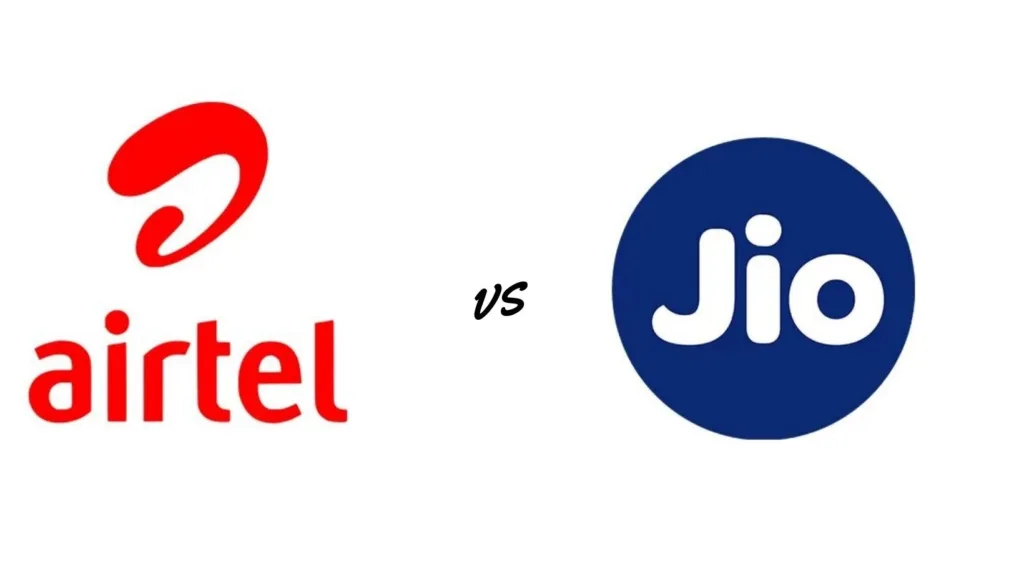The Indian telecom industry has been a battleground witnessing a monumental clash between two titans – Bharti Airtel and Reliance Jio. This ongoing Airtel vs Jio rivalry has not only revolutionized how Indians connect but has also played a decisive role in molding the country’s digital realm. In this article, we delve into the Airtel vs Jio competition, delving into their strategies, innovations, and the transformative impact they have had on India’s telecom sector and the broader digital ecosystem.

Airtel has emerged as a major player in the telecom sector today, and it has become a top sectoral leader. It’s noteworthy that Airtel has strengthened its position with a sharper focus on customers and reasonably healthy balance sheets. In FY21, Airtel faced losses of 12,000 crores, but within a year, it turned around and reported profits of 8,305 crores. In FY23, while Jio generated 1.19 trillion rupees in revenue, Airtel’s revenue reached an impressive 1.39 trillion rupees. Additionally, Airtel’s stock price has consistently outperformed the Nifty over the past six quarters.
The key question is: How did Airtel manage to bounce back after the telecom upheaval of 2016, and what strategies did it employ to compete with Jio in this fiercely competitive market? To understand this complex battle, we need to examine the Indian telecom market’s dynamics and explore the strategies of both Airtel and Jio.
The Indian video consumption market can be categorized into five segments:
- Dark TV Homes: These are homes without access to TV or OTT services, often equipped with feature phones or basic smartphones.
- Free Consumers: Individuals who watch free TV content in exchange for viewing ads.
- TV-First Customers: Subscribers who pay for traditional TV but not for OTT services.
- Digital-First Customers: Users who pay for both TV and at least one OTT service.
- Digital-Only Customers: Subscribers who exclusively consume content on digital platforms.
Jio’s strategy revolves around targeting the lower end of the market, including feature phone users and those with limited access to content. They have introduced the Jio Phone, a low-cost device, and are aggressively pursuing these users. Additionally, Jio offers affordable mobile plans and focuses on sports streaming to attract free TV consumers. They are also expanding their reach into postpaid and broadband services, aiming to create a market for themselves in previously underserved segments.
The Rise of Jio
The seismic shift in the Indian telecom industry can be traced back to 2016 when Reliance Jio made its grand entrance. By offering unprecedented free data and voice services, Jio disrupted the market, compelling established players to rethink their strategies. The telecom sector, previously dominated by a select few, swiftly evolved into a fiercely competitive arena.
jio’s Distinct Strategy
Jio’s strategy was nothing short of revolutionary – democratizing data. Their aim was to make affordable internet access accessible to the masses. To achieve this vision, Jio embarked on massive investments in building a robust 4G network infrastructure, resulting in widespread connectivity, even in remote rural areas. Their budget-friendly data plans and complimentary voice calls enticed millions of users, leading to the creation of an enormous subscriber base.
Jio did not stop at being a mere telecom operator. They ventured into content streaming, introducing services like JioTV and JioCinema. This expansion transformed Jio into a comprehensive digital service provider, not confined to the role of a telecom entity. Their foray into e-commerce with JioMart further cemented their presence in the digital ecosystem.
Airtel’s Steadfast Approach
On the other side of the ring, Bharti Airtel displayed remarkable resilience. Instead of succumbing to the Jio juggernaut, Airtel chose to adapt and innovate. They made enhancing the quality of their services, expanding their network coverage, and improving the overall customer experience their top priorities.
Airtel revamped its strategy by targeting higher-value customers willing to pay for quality services. They initiated a subscriber cleanup to eliminate low-value users, placing a strong emphasis on growing Average Revenue Per User (ARPU). Airtel’s focus on postpaid customers, family plans, and delivering superior network performance not only helped them retain their existing customer base but also attracted new subscribers.
Going Beyond Telecom
Both Airtel and Jio recognized that remaining just telecom operators would no longer suffice in the evolving digital landscape. Airtel took the plunge into the home broadband market, leveraging its existing customer base and infrastructure. Simultaneously, they excelled in the enterprise connectivity space through Airtel Business, serving corporate giants and Small and Medium Enterprises (SMEs) alike.
Jio, on the other hand, extended its reach into various sectors such as e-commerce, healthcare, and education. Their strategic partnerships with global tech giants, including Facebook and Google, underscored their ambition to create an all-encompassing digital ecosystem, covering every facet of daily life.
The Ongoing Battle
The Airtel vs Jio competition remains far from its conclusion. Several intriguing questions loom:
1. Market Segmentation: Jio continues to target the masses, including feature phone users and rural areas. Airtel, however, maintains its focus on quality over quantity. The question remains: Who will emerge as the victor in the battle for market segmentation?
2. Broadband Supremacy: With Jio holding a significant advantage in fiber connectivity infrastructure, can Airtel effectively compete in the home broadband market?
3. Enterprise Connectivity: As Reliance forays into the B2B segment, how will Airtel differentiate its approach in the business connectivity space?
4. Content and Services: Jio has invested substantially in content and digital services. Can Airtel catch up and offer a compelling digital ecosystem?
Conclusion
The Airtel vs Jio saga has rewritten the script for India’s telecom industry and digital landscape. While Jio initially disrupted the established order, Airtel countered with resilience and innovation. Both companies have expanded their horizons beyond traditional telecom, aspiring to become integral components of India’s digital future.
As the battle rages on, consumers stand to benefit the most, enjoying superior services, increased choices, and affordable connectivity. The Airtel vs Jio showdown is not just a corporate rivalry; it represents a pivotal chapter in India’s journey of digital transformation. Only time will unveil the ultimate victor in this monumental battle shaping India’s digital destiny.
Check Out The Best Mobile Phones At Amazon.



